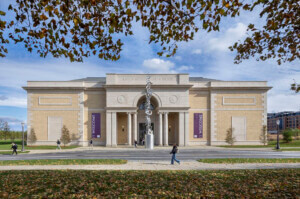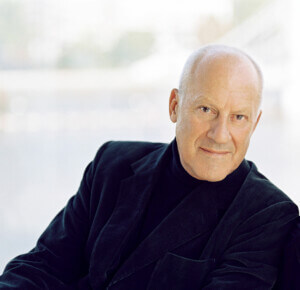“The Brits thought we Americans didn’t know about culture and we thought the Brits didn’t know how to draw,” is how Robert A.M. Stern describes his impression of the first (pre-Beatles) British invasion. In 1962, Norman Foster, along with Richard Rogers and their respective partners, moved to New Haven for a year to study at Yale. Stern spoke about these years last week at a dinner with Foster on the luxurious grounds of Philip Johnson’s Glass House in New Canaan, Connecticut.
The event allowed attendees to walk around the grounds of the estate in all of its fall beauty before the dinner talk. Foster took advantage of this by sprinting with his family through several of the Johnson pavilions. Stern, with his foot in a brace, preferred to lounge in the house with a martini and talk to Peter Eisenman.
The conversation, moderated by Johnson scholar and Glass House Chief Curator Hilary Lewis, also covered the two architects’ relationship with Philip and his “startling” Glass House, as well as Paul Rudolph and the Yale faculty. They both remembered Rudolph’s demanding studios, particularly his juries that might include the likes of Serge Chermayeff and Vincent Scully who all had a “powerful presence on the campus.”
Stern described a studio design by Foster and Rogers that apparently did not impress the jury. The scheme was for a science center, on the edge of New Haven that featured a central pedestrian spine with “ziggurat-like “laboratory clusters spilling down hillside.” Rudolph, Stern said, “did not like the project, and Johnson snapped off one of the towers and said, ‘these will have to go.'”
Stern was at his quotable best all evening and claimed that Foster “has not gotten better, because he was perfect as a student.” Foster was particularly impressed with Scully who, he said, “brought history alive for me for the first time.” Today’s visit to the Glass House, he concluded, made him realize that the New Canaan residence owed its siting to Wright who, Scully claimed, wanted houses “to disappear into the landscape.” (Stern claimed that Wright once asked Johnson, derisively, if he was “still building little boxes on the landscape,” but Wright nevertheless came to the Glass House to drink martinis.) Foster realized that in fact the Glass House was “not a little house on and above the land, but in fact disappears into the landscape,” an observation made clear by the tranquil twilight talk.
Stern and Foster agreed that today, it’s hard to describe how shockingly new the Glass House was to their generation. “I was one of the first students to visit the house,” Stern said. “I did not know Philip Johnson, but I called him on the telephone, and he said, ‘bring the boys down!’ And I showed up with seven women…”
The conversation ended on a more serious note as Foster promoted the goals of his private foundation in Madrid that address issues like climate change and the fact that a quarter of the world’s population has no access to electricity, difficult topics he thinks the profession of architecture avoids. He finished by stating that, for most of the world’s citizens, infrastructure is more important than architecture.
Stern agreed with Foster’s assessment of the architecture profession and claimed that most of today’s star architecture “is about individual ego and not context, [not] a continuation of the street or the history of the city.” Stern sent the audience off to dinner with one of his quotable bon mots: “I like New Canaan but I wouldn’t want to live here.”
Stern and Foster were sent home with an official snow globes from the design store of the house to remember the evening.










